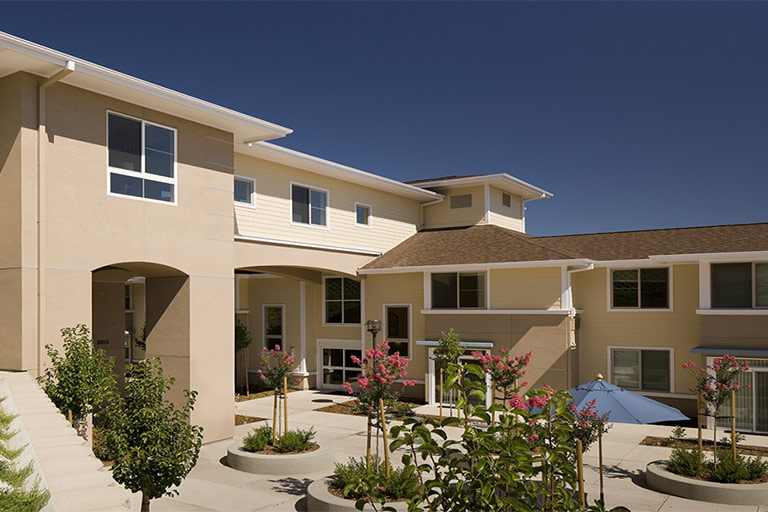
From Tasteful Textures to a Paperless Kitchen — It’s Happening at RiverSpring Living
By Jim Nelson | October 5, 2023
RiverSpring Living sits on 32 acres in Riverdale, New York, a residential neighborhood in the Bronx, just a few miles north of Yankee Stadium. According to its website, RiverSpring’s “park-like” grounds boast “sweeping views of the Hudson River and walkable trails.”
Not every one of RiverSpring’s residents take advantage of those amenities every day, but they all eat every day. To that end, the community features an upscale bistro serving Starbucks coffees and an array of restaurants offering cooked-to-order kosher and non-kosher cuisines. In 2025, River’s Edge will open as NYC’s only life-plan community, adding more upscale fine dining, a coffee shop, a cocktail bar, a juice bar, and a grab-and-go bistro to RiverSpring’s palette.
At the heart of all that eating is Shane Kuhnen, the campus vice president of dining services at RiverSpring. From his mid-teens into his mid-20s, Kuhnen cut his teeth, as it were, in the traditional restaurant world before turning to healthcare and senior living dining. “I really focused my vision on senior care over the last six years,” he told Senior Living News in a recent Zoom call. “It’s something I’m very passionate about.”
SENIOR LIVING NEWS: There must be some significant differences between what a chef does at a traditional restaurant and what you do at RiverSpring.
SHANE KUHNEN: As much as there’s a lot of differences in the process there’s also a lot of similarities. The old-school view of senior dining was hospital food, or this and that, and it couldn’t be more different in today’s world. We’ve realized with education, and as times went on, that you can really glorify the dining experience for seniors in this demographic, even if they have modified textures, diet restrictions, fluid restrictions — whatever it may be. You have the opportunity to give them a first-class experience at what I like to consider their home — we work at their house. Some people come out to dinner and get to order what they want with no restrictions; seniors, unfortunately, some that are medically compromised have to make some adjustments in their personal decisions to ensure that they stay healthy and strong.
SLN: How do you track each resident, what they can and cannot eat?
SK: We serve over 650 residents every single day, breakfast, lunch, and dinner, so we have a team of seven registered dieticians that really hone in on the diet and clinician portion of the residents’ food program. We take that information they collect, based on assessments, based on doctor’s orders, and then we have the opportunity to custom make a menu for that resident that is not only nutritionally adequate, but also tastes great.
SLN: So, do you create a menu that keeps all of these things in mind so that each resident will find some things on the menu that will work for them?
SK: We have a seasonal menu and then we have an extensive, always-available menu. At the same time, we’re also preparing 150 meals a day for kosher residents. The complexity of our menu is actually very extensive: In a given meal service, you could be serving spaghetti and meatballs, grilled cheese, a cheeseburger, a chicken wrap, and a bowl of cereal.
We go off of a baseline menu that we create at the corporate level, and then we modify it through the resident food committees. We’ll take this corporate menu, usually a four-week or five-week menu, and then we will customize it based on feedback at the resident food committees — these residents are kind of the voice of the 650. We have our RDs meet with these residents one on one, as well, but even more so inside that food committee we have the opportunity to hear the most vocal residents and we really customize it so by the time we run that seasonal menu one more time for that season it’s very specifically focused on providing what the residents actually want on their meals.
SLN: With the challenges must come a lot of rewards.
SK: It’s funny you say that Jim, and I don’t just say this: There’s no more rewarding feeling than taking care of somebody that can’t take care of themselves. A lot of these residents, you don’t like to discuss it, but they could be in their 11th hour. They took care of their kids, they took care of their grandkids, they worked their whole life, and now they’re unable to take care of themselves. I think it’s the most rewarding job on the entire planet when you can bring happiness to these people. We always talk about in our department that we have the chance to make 700 people’s day today.
SLN: Switching gears, let’s talk about your state-of-the-art culinary program at RiverSpring.
SK: Our company rolled out an entire Tasteful Program: Tasteful Plus and Tasteful Textures. Our Tasteful Plus program is an enriched foods program for residents who are not getting an adequate amount of calories in a day, that may be losing weight. The food is very enjoyable, but at the same time the residents are getting their nutritional adequacy in every single meal.
I think the one that really moves people is our Tasteful Textures program, a modified food program for residents that have different levels of dysphagia — residents that have trouble swallowing, or need their foods puréed, minced and moist — we have a way of delivering that food in a dignified fashion, so that the residents are not only getting the food that they want, it’s being prepared the exact same way as everybody else. We actually make the purée plate look identical, or very close to, a regular plate. We have the opportunity of layering flavors. A good example would be lasagna, where we actually take the same lasagna that the other residents are eating; we purée the pasta, then we purée the ricotta cheese, we purée the Italian seasoned beef, and then we put the pasta back down, the sauce, the cheese, and it’s a layer of flavors; you have identified flavors.
SLN: What else is new and exciting in the dining side of things at RiverSpring?
SK: We’ve put in some waste programs here in the main kitchen where we’re weighing all of our scraps and any leftovers to ensure, not only fiscally, that we’re being responsible, but also environmentally; we don’t want things going into the trash. We don’t want to overproduce. There’s too many people in this city alone, let alone the country, that can’t have three meals a day. We want to make sure that we’re not being wasteful, that we’re being mindful, that the food that we’re serving we’re not just taking for granted. So, we have a food waste sustainability program with Leanpath where we weigh our waste, it shows the fiscal responsibility and the emissions responsibility. So that’s a big thing that we’re doing here.
We’re also focused on implementing a paperless kitchen, where everything is tablet driven. Back-of-house excellence, having AI involved in every single day of our operation based on production sheets, based on resident requests; we have real-time adjustments to any resident, so if a resident puts in a certain request, the second the doctor order goes in we get it in real time.


